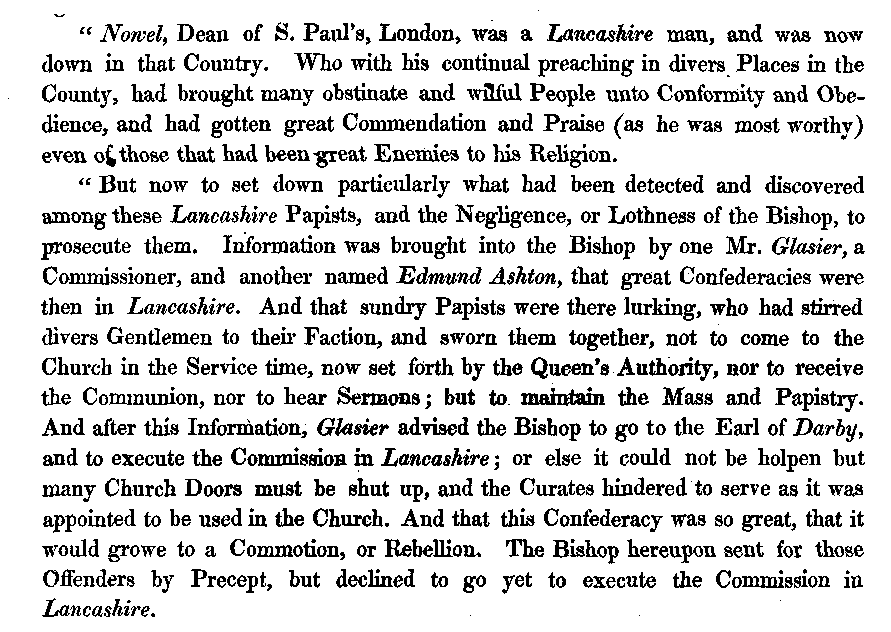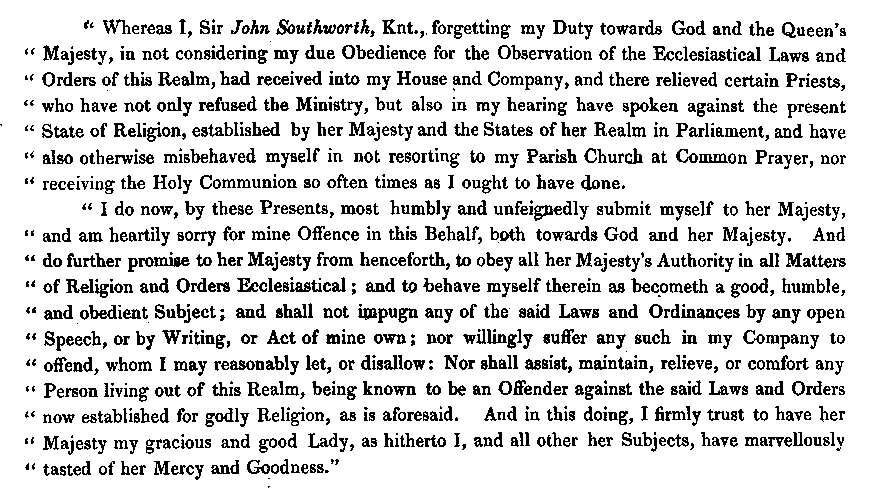
Progress after the Dissolution of the abbeys and the reformation of the church by Henry VIII
Time-line
Henry VII ----> 1509
Dissolution ----> 1537
Henry VIII ----> 1547
Edward VI ----> 1553
Mary ----> 1558
Elizabeth ----> 1603
James I ----> 1625
Charles I ----> 1649
Paslew executed ----> Spring 1537
Following the Dissolution of the Abbeys, the break with Rome, and the establishment of the new church, most of the remainder of the reign of Henry VIII was spent in disposing of the spoils. Little happened during the reign of Edward VI, but when Mary came to the throne in 1553, she reverted the country to the church of Rome. During the reign of Mary, prominent members of the newly established Church of England, such as Lawrence and Alexander Nowell of Read were under pressure, and the Nowells spent the period in exile, mainly in Frankfurt.
During Mary's reign there was almost continual threat of invasion of the north of England from Scotland, and mary ordered a Military Muster in 1553 to cope with the threat. the Muster in Lancashire, for the Blackburn hundred proposed a muster of 400 men, 175 of them from the Whalley parish. The leaders of the Blackburn contingent werte to be; Richard Shireburn, Thomas Talbot, John Southworth, John Towneley, Thomas Catterall and John Osbolston [sic.].
The muster was repeated again in 1559 at the start of Elizabeth's reign with very similar results.
At the 1574 muster, the same leaders were returned, but including Roger Nowell and Richard Assheton as well. William Starkie and Hugh Shuttleowrth were also named, but with a very minimal contribution of 1 long bow and 1 sheaf of arrows towards the defence of the country.
With the coronation of Elizabeth, the prime concern was the state of the church and the reformation. Although the conversion from Rome had occurred relatively quickly in the rest of the country, the progress was slow in Lancashire, where it was reported that mass was still performed regularly and priests harboured. The Book of Common Prayer in English established by law was in litle use. In 1559, Elizabeth set up a commision to enquire into the tardiness of the Lancastrians. Bishop Downham of Chester was loath to proceed with the commission, despite repeated requests and advices, and in 1567 he was reprimanded by Elizabeth in the terms:
"... the bishop is required to make personal visitations, by repairing to the most remote parts of his diocese, and especially lancashire."
The Bishop complied, though complaining bitterly in his report of the heat and dryness of the weather, and the hardships he had suffered. However, he said he had obtained agreement from all the clergy and gentry. The commission, apparently not over-impressed with promises, insisted the agreements be reinforced by financial bonds.
Elizabeth's next move was to send Dean Nowell of St. Pauls back to his home country to preach the royal message around the area. His preaching, though strong enough to incite the Spanish to send the Armada, was apparently less successful in Lancashire.

In its attempt to enforce the reformation of the church in Lancashire, the commission had prepared a form of accptance to be signed by 'obstinate' gentry. The form submitted to Sir John Southworth of Salmesbury (but NOT signed by him) has survived.

Adherence to the pold Catholic religion was strong throughout the north of England, and there was an attempt by many leading families to re-establish the old faith and place Mary Queen of Scots on the English throne in place of Elizabeth. The plot was led by the earls of Northumberland and Westmorland in 1569, but failed when they tried to enlist the support of the Earl of derby who reported the plot to the Queen. The revolt was quickly repressed before it really got going, and 57 noblemen were attainted - none of them from Lancashire.
At this period, the main supporters of the Queen and the reformed church in the Blackburn hundred appear to have been Richard Shyreburn, Rychard Assheton and John Braddyl who were prepared to pledge support.. Not too surprising as the Whalley Abbey estates had passed to Assheton and Braddyl. Locally, many adhered to the old religion; in Har. MS folio 33, among the recusants listed in 1575 were, Thos. Catterall and his wief, Anne Towneley [Anne Catterall, daughter of Thonmas Catterall], wief of Henry Towneley [of Barnside], John Southworth and the ladie his wief, Thomas Southworth his sonne and heire, Anne Southworth his daughter, Dorothy Southworth his sister, John Talbot, (again) Thos. Catterall and his wief, and John Towneley and his wief [Anne Catterall, daughter of Ralph and Elizabeth].
At the end of this document, the names of the 12 principal offenders are again repeated with the comment "If these could be re-claimed we think th others would follow." On this list are John Southworth, John Talbot, John Towneley and Thom. Catterall.
By 1580, Elizabeth was pressing harder for conformity in Lancashire,
"The queen, having granted the fines laid upon certain popish recusants in Lancashire to Mr. Nicholas Annesley, and he having been obliged to take out a distringas on their lands and goods, the commission are to see that the said distringas is duly executed by the sheriff and the forfeiture paid to Mr. Annesley."
In 1581 prosecution against the recusants was more strongly presed, and John Shuttleworth, John Townely and Thomas Hesketh were fined and imprisoned. The other Catholic diehard, Thomas Catterall had died in 1579. They (and a total of 16 recusants) were held in the new Fleet prison in Manchester. A probable cause of the arrests was provided (unwillingly upon the rack in London) by the Catholic priest and martyr, Edmund Campion (see Evelyn Waugh's biography). Having passed through Lancashire, preaching the Catholic doctrine, in early 1580 (or 1581?) he revealed that he had stayed at the houses of Talbot, Thomas Southworth and Bartholomew Hesketh, and remained with Talbot and Southworth between Easter and Whitsuntide.
With local sympathey, the imprisonment of Southworth and Towneley was relaxed in 1582 (i.e. more privileges, but still in prison). In July 1582, the cost of maintaining the 16 recusants (in a style appropriate to their status) was proving beyond the means of the prison, and the justices of Lancashire offered a year's contribution and urged the justices of Cheshire to do the same. Since the cost of maintaining these recusants is given as 650 pounds, we must conclude that there was still considerable sympathy for Catholics in Lancashire in 1582, 46 years after the reformation.
In March 1584, the recusants were still imprisoned in the Fleet in Manchester, but at the request of Dean Nowell, permission was given for Mr. Towneley (brother-in-law of the Dean) to go to London for medical advice. By June, both Southworth and Towneley had been moved to London, "although they had paid their fines and could no longer remain justly committed" ... [however] ... "they could do less mischief in London than in Lancashire."
There is an illuminating reference to the problem of why Thomas Catterall should have passed over his only son James in the inheritance of the manor of Little Mitton, Sir Francis Walsingham wrote to the Bishop of Chester in 1584, instructing him
" ... inquire into the reason why sir John Southworth is minded to disinherit his son ....and to take care to prevent his doing so."
The pursuit of the Lancashire recusants continued, and a folio in the Harl. MS dated 1586 contains a list of "Names of such as are detected for receiptage of Priests, Seminaries etc. in the Countie of Lancaster". In this there appears, by presentation of the Vicar of Whalley, one
"John Lawe a seminarie priest receipted in diverse parts of Lancashire as specially in the parishes of Ormskirk, Preston, Blackburn and Whalley."
In the same document, Sir John Southworth of Salmesbury is reported to have receipted, relieved and maintained at the lodge of Sir John in Salmesbury Park, one Mr. Richard Brittaine, a priest. There were masses said daily at the Lodge.
Some 20 years later, John Lawe, 'a pedlar' and an old man apparently had a major stroke on his way to visit Alice Nutter at Roughlee in Pendle. He wasvisited, while paralysed down one side, by his son from Halifax. Alizon Device, a daughter of one of the poorest families in Pendle was arraigned by the Justice of the Peace, Roger Nowell of Read (his great grandfather had married Grace Catterall of Mitton) on a charge of bewitching John Law. Alice Nutter, who was of an old Catholic family, and currently engaged in a boundary dispute with Roger Nowell of a strong protestant family, was also arraigned as a witch and both were found guilty and executed at Lancaster in 1612. (See Pott's 'Wonderful Discoverie of Witches ...'.)
The next major breakout of witchcraft in the area happened on the Southworth's estate at Salmesbury in 1633.
It is just possible there may have been some confusion between Catholicism and witchcraft in the hundred of Blackburn at this period.